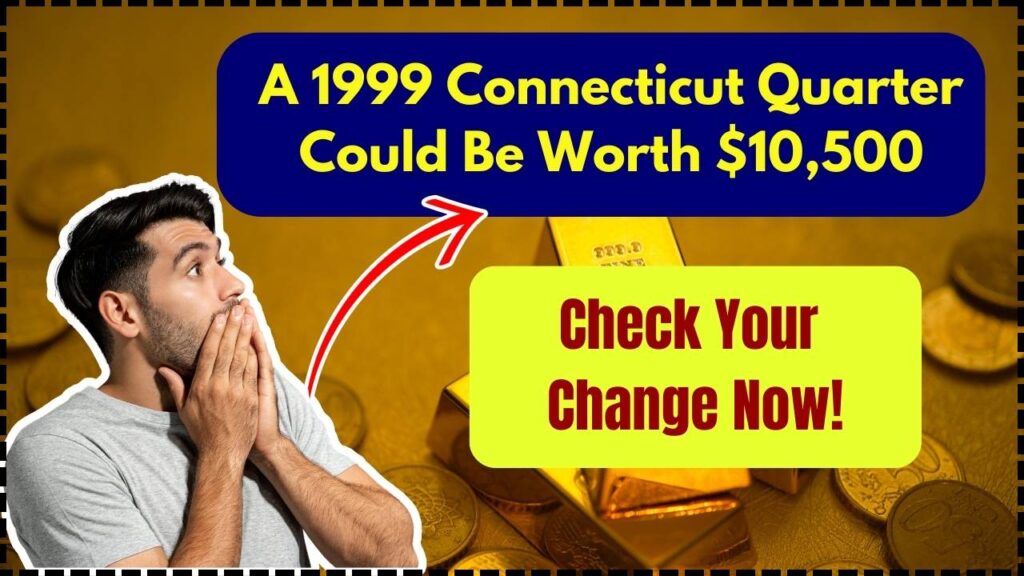A 1999 Connecticut Quarter Could Be Worth $10,500: Finding a valuable coin in your pocket change might feel like winning the lottery, and with certain 1999 Connecticut quarters, that dream could become a reality. This quarter, part of the U.S. Mint’s 50 State Quarters Program, holds a fascinating history and a surprising potential value of up to $10,500. Let’s dive into why these coins are worth so much, what to look for, and how you can determine if your quarter is a hidden treasure.

A 1999 Connecticut Quarter Could Be Worth $10,500
| Feature | Details |
|---|---|
| Coin Name | 1999 Connecticut Quarter |
| Potential Value | Up to $10,500 |
| Key Factors | Minting errors, condition, rarity |
| Top Sale Record | $10,500 for an experimental planchet error |
| Grading Criteria | MS68 and higher for high-grade coins |
| Resources | Official U.S. Mint Website |
The 1999 Connecticut quarter is a fascinating piece of numismatic history, with some coins worth up to $10,500 due to rare errors and exceptional condition. By carefully inspecting your change and understanding what makes these coins valuable, you might just discover a hidden treasure. If you believe you have a valuable coin, consult a professional grading service to confirm its worth. Collecting coins can be a rewarding hobby and even a profitable investment if approached with knowledge and care.
What Makes the 1999 Connecticut Quarter Special?
The 1999 Connecticut quarter is part of the iconic 50 State Quarters Program, which aimed to celebrate each state’s unique heritage. Connecticut’s design features the Charter Oak, symbolizing independence and resilience. While most of these coins are worth their face value of 25 cents, certain rare variations can fetch thousands of dollars at auction.
The key to understanding the potential value of these coins lies in two areas: minting errors and condition. Rare errors, like being struck on the wrong type of metal or experimental planchets, can significantly increase a coin’s value. Similarly, coins in pristine condition (graded MS68 or higher) are highly sought after by collectors. Additionally, coins with exceptional aesthetic appeal, such as deep luster or particularly strong strikes, may also command premium prices even in slightly lower grades.
Why Some 1999 Connecticut Quarters Are Worth Up to $10,500
1. Minting Errors
One of the most valuable types of 1999 Connecticut quarters comes from minting errors. Here are some examples:
- Experimental Planchet Errors: Some quarters were mistakenly struck on planchets intended for the Sacagawea dollar. These coins appear slightly thicker, heavier, and may have a golden hue. An experimental planchet error coin sold for $10,500 in 2018. These errors were part of testing conducted by the U.S. Mint to explore alternative materials, making these coins exceptionally rare and desirable.
- Double Strikes and Misalignments: Coins with noticeable double strikes or off-center designs are also prized by collectors. Such errors occur during the striking process when the coin shifts, resulting in overlapping or incomplete impressions.
- Clipped Planchets: Sometimes, a coin’s edge may appear clipped or irregular due to improper cutting during production. This error, while less valuable than experimental planchets, still holds significant interest among collectors.
2. Exceptional Condition
Condition plays a critical role in determining a coin’s value. Professional grading services like PCGS and NGC grade coins on a scale from 1 to 70. Coins graded MS68 or higher are extremely rare and can fetch thousands of dollars. For example, a 1999-P Connecticut quarter graded MS68 sold for $4,362 in 2006. High-grade coins exhibit features such as:
- No visible wear or scratches under magnification
- Strong, detailed strikes with sharp edges
- Original mint luster without discoloration or toning
Additionally, proof coins minted for collectors—distinguished by their mirror-like finish and sharper details—may also have enhanced value, particularly if they feature errors or are graded PR69 or higher.
How to Identify a Valuable 1999 Connecticut Quarter
Step 1: Inspect the Coin’s Features
Start by examining the coin carefully:
- Mint Mark: Look for the mint mark on the obverse side near Washington’s ponytail. The letter “P” indicates it was minted in Philadelphia, “D” for Denver, and “S” for San Francisco (proof coins).
- Date: Ensure the coin is from 1999 and part of the Connecticut series.
- Design Details: Pay close attention to the Charter Oak design. Weak or irregular details may indicate an error coin.
Step 2: Check for Errors
Use a magnifying glass to spot minting errors such as:
- Misaligned designs
- Double strikes
- Unusual coloration or thickness
- Clipped or incomplete edges
Step 3: Assess the Condition
Coins with no visible scratches, wear, or discoloration are more valuable. If you believe your coin is in exceptional condition, consider having it graded by a professional service like PCGS (Professional Coin Grading Service) or NGC. These services provide certification and protection for your coin’s value.
Step 4: Compare with Similar Coins
Research auction results and online marketplaces for coins of the same grade and features. Websites like Heritage Auctions or the PCGS Coin Price Guide can help you gauge your coin’s market value.
Coin Collectors – Where Can I Find Donald Trump’s Bronze Medal?
Lincoln Wheat Penny Worth $25 Million? Here’s How to Spot This Rare Coin!
$150,000 for an 1829 Capped Bust Dime? Discover 5 Other Rare and Iconic Coins!
FAQs About A 1999 Connecticut Quarter Could Be Worth $10,500
Q1: How can I get my 1999 Connecticut quarter appraised?
You can have your coin appraised by professional grading services such as PCGS or NGC. These organizations provide accurate evaluations and official certification of a coin’s grade. Additionally, some local coin shops offer appraisal services, but ensure they are reputable before proceeding.
Q2: Are all 1999 Connecticut quarters valuable?
No, the vast majority of these quarters are only worth 25 cents. Only coins with rare errors or in exceptional condition are worth significantly more. However, if you suspect your coin is unique, it’s worth further investigation.
Q3: How do I know if my quarter has an experimental planchet error?
Experimental planchet error coins are typically heavier, thicker, and may have a golden hue. If you suspect your coin is one of these, have it evaluated by a professional. Weighing the coin and comparing its dimensions to standard quarters can also provide clues.
Q4: What should I do if I find a valuable quarter?
If you discover a potentially valuable quarter, handle it carefully. Avoid touching the surface directly; instead, use gloves or hold it by the edges. Store it in a protective holder and consult a professional grading service for authentication.
Tips for Coin Collectors and Sellers
- Store Coins Properly: Keep coins in protective holders to prevent scratches and tarnish. Avoid exposing them to extreme temperatures or humidity.
- Do Your Research: Use reliable sources like the U.S. Mint or coin grading services to learn more about your coin.
- Join Coin Collecting Communities: Online forums and local clubs can help you connect with experienced collectors and buyers. Communities such as CoinTalk or the American Numismatic Association provide valuable resources and networking opportunities.
- Avoid Cleaning Coins: Cleaning can reduce a coin’s value, especially for collectors seeking original surfaces. Even light cleaning can damage a coin’s patina and lower its grade.
- Keep Detailed Records: Maintain records of your coin collection, including purchase receipts, grading certificates, and auction results, to track their provenance and value.








